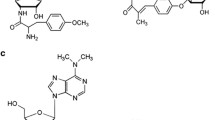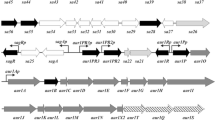Abstract
ThepurA gene ofThiobacillus ferrooxidans encoding adenylosuccinate synthetase [EC 6.3.4.4] was identified in the upstream region of theiro gene encoding Fe(II)-oxidase (J. Biol. Chem 267:11242–11247, 1992). ThepurA gene consisted of 1290 base-pairs, which translated into a 29-amino-acid protein. The gene is functionally active, because it is able to complement anEscherichia coli purA-deficient strain. The deduced gene product has a high degree (60.9%) of sequence identity with that (432 aa) ofE. coli purA gene, and both the products share GDEGKGK-DETG-TKLD sequences which are supposed to be GTP-binding domain. The downstream region of theiro gene contained another open-reading frame (ORF) of 1218 bp, and this showed high homlogy (56.6% over 249 bp) withE. coli ORF-II, which is found as a second ORF and truncated form in the downstream region of thepurA gene. Comparison of the gene organization in the flanking region ofpurA gene betweenT. ferrooxidans andE. coli is also described.
Similar content being viewed by others
Literature Cited
Amaya Y, Nakano A, Ito K, Mori M (1990) Isolation of a yeast gene, SRH1, that encodes a homologue of the 54k subunit of mammalian signal recognition particle. J Biochem 107:457–463
Bass MB, Fromm HJ, Stayton MM (1987) Overproduction, purification, and characterization of adenylosuccinate synthetase fromEscherichia coli Arch Biochem Biophys 256:335–342
Bernstein HD, Poritz MA, Strub K, Hoben PJ, Brenner S, Walter P (1989) Model for signal sequence recognition from amino-acid sequence of 54k subunit of signal recognition particle. Nature 340:482–486
Birnboim HC, Doly J (1979) A rapid alkaline extraction procedure for screening recombinant plasmid DNA. Nucleic Acids Res 7:1513–1523
Chamberlain JP (1979) Fluorographic detection of radioactivity in polyacrylamide gels with the water-soluble fluor, sodium salicylate. Anal Biochem 98:132–135
Clanton DJ, Hattori S, Shih TY (1986) Mutations of the ras gene product p21 that abolish guanine nucleotide binding. Proc Natl Acad Sci USA 83:5076–5080
Dever TE, Glynias MJ, Merrick WC (1987) GTP-binding domain: three consensus sequence elements with distinct spacing. Proc Natl Acad Sci USA 84:1814–1818
Fukumori Y, Yano T, Sato A, Yamanaka T (1988) Fe(II)-oxidizing enzyme purified fromThiobacillus ferrooxidans. FEMS Microb Lett 50:169–172
Hann BC, Poritz MA, Walter P (1989)Saccharomyces cerevisiae andSchizosaccharomyces pombe contain a homologue to the 54-kD subunit of the signal recognition particle that inS. cerevisiae is essential for growth. J Cell Biol 109:3223–3230
Hattori M, Sakaki Y (1986) Dideoxy sequencing method using denatured plasmid templates. Anal Biochem 152:232–238
Ingledew WJ (1982)Thiobacillus ferrooxidans. The bioenergetics of an acidophilic chemolithotroph. Biochim Biophys Acta 683:89–117
Inoue H, Nojima H, Okayama H (1990) High efficiency transformation ofEscherichia coli with plasmids. Gene 96:23–28
Jessee J (1986) New sub-cloning efficiency. Competent cells >1×106 transformants/μg. Focus 8:9
Jones DT, Reed RR (1989) Golf. An olfactory neuron specific-G protein involved in odorant signal transduction. Science 244:790–795
Kozasa T, Itoh H, Tsukamoto T, Kaziro Y (1980) Isolation and characterization of the human G2α gene. Proc Natl Acad Sci USA 85:2081–2085
Kusano T, Takeshima T, Sugawara K, Inoue C, Shiratori T, Yano Y, Fukumori Y, Yamanaka T (1992) Molecular cloning of the gene encodingThiobacillus ferrooxidans Fe(II) oxidase: high homology of the gene product with HiPIP. J Biol Chem 267:11242–11247
Laemmli UK (1970) Cleavage of structural proteins during the assembly of the head of bacteriophage T4. Nature (London) 227:680–685
Lauffer L, Garcia PD, Harkins RN, Coussens L, Ullrich A, Walter P (1985) Topology of signal recognition particle receptor in endoplasmic reticulum membrane. Nature 318:334–338
Lewin, B. (1990) Genes (4th ed) Oxford University Press, Oxford Laboratory, Cold Spring Harbor, N.Y.
Mizusawa S, Nishimura A, Seela F (1986) Improvement of the dideoxy chain-termination method of DNA sequencing by use of deoxy-7-deazaguanosine triphosphate in place of dGTP. Nucleic Acids Res 14:1319–1324
Nakano A, Muramatsu M (1989) A novel GTP-binding protein, Sar1p, is involved in transport from the endoplasmic reticulum to the golgi apparatus. J Cell Biol 109:2677–2691
Pai EF, Kabsch W, Krengel U, Holmes KC, John J, Wittinghofer A (1989) Structure of the guanine-nucleotide-binding domain of the Ha-ras oncogene product p21 in the triphosphate conformation. Nature 341:209–214
Römisch K, Webb J, Herz J, Prehn S, Frank R, Vingron M, Dobberstein B (1989) Homology of 54k protein of signalrecognition particle, docking protein and twoE. coli proteins with putative GTP-binding domains. Nature 340:478–482
Sambrook J, Fritsch EF, Maniatis TE (1989) Molecular cloning: a laboratory manual (2nd ed). Cold Spring Harbor, N.Y.: Cold Spring Harbor Laboratory Press
Sancar A, Hack AM, Rupp WD (1979) Simple method for identification of plasmid-coded proteins. J Bacteriol 137:692–693
Sanger F, Nicklen S, Coulson AR (1977) DNA sequencing with chain-terminating inhibitors. Proc Natl Acad Sci USA 74:5463–5467
Shine J, Dalgarno L (1974) The 3′-terminal sequence ofEscherichia coli 16S ribosomal RNA: complementarity to nonsense triplets and ribosome binding sites. Proc Natl Acad Sci USA 71: 1342–1346
Shiratori T, Inoue C, Sugawara K, Kusano T, Kitagawa Y (1989) Cloning and expression ofThiobacillus ferrooxidans mercury ion resistance genes inEscherichia coli. J Bacteriol 171:3458–3464
Stayton MM, Rudolph FB, Fromm HJ (1983) Regulation, genetics, and properties of adenylosuccinate synthetase: a review. Curr Top Cell Regul 22:103–141
Wakao N, Mishina M, Sakurai Y, Shiota H (1982) Bacterial pyrite oxidation. I. The effect of pure and mixed cultures ofThiobacillus ferrooxidans andThiobacillus thiooxidans on release of iron. J Gen Appl Microbiol 28:331–343
Wolfe SA, Smith JM (1988) Nucleotide sequence and analysis of thepurA gene encoding adenylosuccinate synthetase ofEscherichia coli K12. J Biol Chem 263:19147–19153
Yanisch-Perron C, Vieira J, Messing J (1985) Improved M13 phage cloning vectors and host strains: nucleotide sequences of the M13mp18 and pUC19 vectors. Gene 33:103–119
Author information
Authors and Affiliations
Rights and permissions
About this article
Cite this article
Kusano, T., Takeshima, T., Inoue, C. et al. Identification of thepurA gene encoding adenylosuccinate synthetase inThiobacillus ferrooxidans . Current Microbiology 26, 197–204 (1993). https://doi.org/10.1007/BF01577377
Issue Date:
DOI: https://doi.org/10.1007/BF01577377




